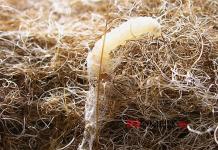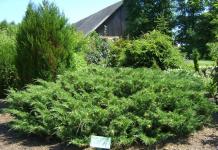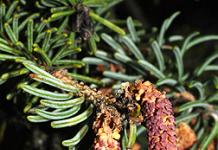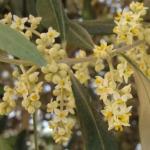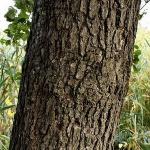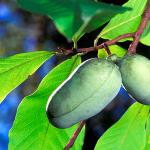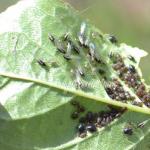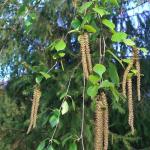While friends and relatives enthusiastically grow decorative flowers at home, in my apartment you can only see useful plants: lemon (though it’s still lazy, that is, it hasn’t produced fruit yet), rosemary, mint. This year there was also an olive tree.
I really wanted to see how olives grow in person! Well, of course, try them not from a store jar. And this is what I got...
Olive trees first appeared in the Mediterranean. Now they are grown (in gardens) in India and Crimea, Greece and Turkmenistan, Georgia and Mexico.
By the way, in any country this is a cultivated tree grown by people. There are no wild olives anywhere - this culture “became friends” with humans so long ago that there are no traces of its “separate,” that is, wild, existence.
In our latitudes, many have tried to “establish” the olive in the garden (doesn’t it work with heat-loving peaches?), but so far no one has succeeded. But planting such a tree in the house, and even collecting the fruits, is no longer a new thing.
This crop blooms once every 2 years. The beginning of flowering is from late April to June.

The flowers resemble clusters of forty small flowers, which over time transform into small “knuckles” of deep purple, black or green. They ripen for a relatively long time - up to 5 months.

A tree (garden) can bear fruit for up to 20 years. When this period ends, it should be replaced with a younger one.
How to get a potted olive
It can be planted by rooting the cuttings. You can buy it or receive it as a gift (although this option is already several times more expensive - a good two-year-old tree with viable roots can cost up to 20 thousand, or even more).
They will tell and show how an olive tree propagates using cheap (or completely free) cuttings in the video:
You can also grow an olive from a pit. But not from a canned fruit (everything alive has been “nailed” into it for a long time), but from a purchased seed, or, in extreme cases, from a fresh or dried olive.
True, there is a lot of hassle here, and such a tree will begin to bear fruit only in the 12th year of its life, while a “cutting” tree will begin to bear fruit only after 3 years.
Are there many types and varieties of olive trees?
Olive trees belong to the Olive family, so their “cousins” include privet, ash, lilac, and jasmine.
There are about thirty types of olive trees.
The most popular on our mainland are the Cape olive, golden-leaved olive, and European olive.

All trees can be divided into three groups:
- Oil olives. They are cultivated for the production of oil, so it is not worth growing one of these varieties at home - their fruits are not that good for snacks. What are these varieties called? Let's say Biancolilla, Caione, Taggiasca, Frantoño.
- Universal (combined). Such olives can be canned and pressed into oil.
- Table varieties. The most delicious ones are best prepared in jars. They are most recommended for indoor gardening. Varieties popular with farmers: Sabina, Lucca, Zinzala, Cerignola. As for growing at home, people really praise the varieties Razzo, Della Madonna, as well as the more “our” varieties Krymsky, Nikitinsky, Urtinsky.
Remember: a tree growing on a windowsill will not overwhelm you with fruits. 15 pieces (600 g) is how many olives you can collect from such a plant. But how beautiful it will look!

How to grow an indoor olive tree
- Lighting. You need as much of it as possible. A small tree can be kept on a windowsill (even a southern one), but if you put an adult tree in a corner, then only in the most illuminated one. A loggia or balcony is an excellent place for an indoor fruit tree.
- Temperature. In spring and summer (through September inclusive), you can keep the olive in any room, and in autumn and winter - in a cool room (where it stays no higher than 12 degrees Celsius).
- Watering. Maximum. As soon as the top of the soil in the pot dries, water it well (so that the moisture reaches the bottom of the pot). On average, this is done 2 to 3 times a week.
- spraying. They should be carried out in the summer (in the heat), as well as in the winter (if your olive winters not in a cold room, but in a living room, and there is a battery nearby).
- Nutrition. In spring, the olive should be fed twice a month with preparations (or organic matter, after all, you have a fruit tree) containing nitrogen. In summer, the tree is given complex mineral fertilizer. Also, some people praise spraying olives with succinic acid. Even people can drink this drug (vitamin), so it definitely won’t harm the fruit tree. The only thing is that succinic acid will not replace the rest of the diet; it can only serve as a supplement to it.
- Pruning. We grow this plant only secondly for its fruits, and firstly for its beauty. Therefore, in the spring you can pick up a pruning shear and safely form a perfect ball from the crown. When choosing between two branches, always give preference to the stronger one.

Transfer
It is needed because the roots of the olive eventually rest against the walls of the pot and outgrow it. The tree is transshipped once every 2 years.
- Pot. The best one is made of clay, a couple of centimeters larger than the previous one.
- Priming. It can be anything, the main thing is that it is not sour. Often, “indoor gardeners” take a universal substrate containing compost (humus), sand, turf and leaf soil, and peat. The presence of lime is also normal. Before planting the tree, mineral fertilizers are applied to the soil.
- Don’t forget about drainage at the bottom of the pot (broken brick, expanded clay).
A separate story is transplanting a diseased olive. Most often, these trees suffer from root rot (it starts from frequent overwatering). The disease is easily recognized by wilting and falling leaves. The tree needs to be dug up urgently, the diseased roots should be cut off, and the sections should be treated with activated carbon.
The olive is transferred to fresh soil. The final touch is to remove some branches, because a sick tree will not have the strength to feed them.

Important conditions without which the harvest cannot be harvested
- 1.5 months before the start of flowering, strictly monitor your pet’s “diet”: it should receive plenty of watering and nutrition.
- Wintering in a cold room affects the number of fruits. If you move the pot to an insulated loggia or closed veranda from November (or just keep the olive there all the time), the plant will rest and produce the maximum number of buds. But remember: it should not be below 10 degrees; the olive is still afraid of the cold.
- When pruning, remove old branches - it is the developing “young growth” (last year’s shoots) that bears fruit.

Caring for a flowering plant
- The tree can and should be sprayed; the flowers are not afraid of this procedure.
- Make sure the tree gets plenty of light. If the days are cloudy (according to the law of meanness, this is always the case...), the olive can even be illuminated.
- Water the tree only when the top of the soil is dry, and not before. Moreover, pour in a little less water than always - during this period the olive is especially sensitive to overwatering.
European olive or European olive (Olea europaea) is a beautiful tree; an adult specimen is often gnarled. Olive is widespread in the Mediterranean region, where it has been cultivated for centuries. The olive tree is a symbol of peace and new life. Greek legend says that the first olive tree grew on the Acropolis from the spear of Athena; its destruction was associated with severe punishment. Olives are primarily useful plants. Wood is used to create various household items; due to its slow growth, it is quite expensive. The fruits are widely used in cuisine and cosmetics.
How to Grow an Olive Tree
The European olive grows as a tree or large shrub and can reach a maximum height of 15 m. It has a highly branched but transparent crown. It grows slowly and is long-lived - you can often find several hundred-year-old specimens. The trunk is not simple, clumsy, covered with gray bark, empty in the middle. The bark of young trees is greenish and smooth. Olive leaves are leathery, oppositely arranged, 3-8 cm long, dark green above, silvery below. The small flowers are rather inconspicuous, slightly fragrant, and have a creamy yellow color. They appear in spring on last year's shoots. Pollination requires pollen from another tree. The fruits are drupes called olives, which in Europe begin to be harvested when the fruits have not reached full maturity. The fruits can be green, white, reddish, purple or black. Thanks to their use, the fruits are divided into larger and fleshier ones - table olives, smaller and harder ones, intended for the production of olive oil.
Place
The European olive loves the sun. Should grow in the sunniest location. In summer, it is better to take the pot outside, gradually accustoming it to direct sunlight. First set for 10 days in partial shade, moving to a brighter place in subsequent days. If you do not do this, there is a high risk of leaf burns (brown spots appear on the leaves).
The soil
The soil for the olive tree should be, first of all, permeable, and in the case of large specimens, clayey. Sandy soils are the best. The substrate should be enriched with materials that improve permeability (gravel, expanded clay, perlite), and a layer of drainage should be placed at the bottom of the pot.

Watering
Olive does not have great watering requirements. The soil should not be too wet. Overwatering should be avoided as it can lead to root rot. True, olives can tolerate short-term drought, but the soil should not dry out completely. In their natural environment, plants have to wait a long time for rainfall, so they are adapted to extract water from the ground with extremely wide, branching roots. This is not possible at home, so it is better to always keep the soil slightly moist.
Fertilizer
Fertilize the tree regularly from March to September with a universal multi-component fertilizer.

Temperature
During the growing season, it is necessary to ensure the highest possible temperature. In winter, 10 °C is sufficient. In a bright winter garden they can winter at a temperature of 15 °C. Olives are not frost-resistant; adult specimens can withstand short-term temperature drops down to -10 °C. Young specimens are especially sensitive to frost, especially the roots, which immediately experience damage. Plants grown at home and exposed to the open air in the summer must be promptly removed.
Trimming
Olives are pruned in the spring at the beginning of the growing season or in the fall. It is worth trimming the shoots regularly to give them a good shape. Flowers appear in summer on this year's shoots. Pruning will not harm the plant; the tenacious olive will withstand severe pruning.
Reproduction
Olive trees are propagated by grafting. Cuttings are difficult to root. For propagation, it is better to use cut parts of the shoots after preliminary immersion in the rooting agent. Seeds are sown in spring. This is so problematic that fresh seeds are needed; seeds take a long time to germinate.
Diseases and pests
Scale insects can appear when the plant is exposed to too high a temperature. In spring, aphids and powdery mildew attack young leaves. Overdrying of the substrate causes fruits and petals to fall off; after watering, the plant quickly recovers. In winter, if the place is too warm and dark, the olive tree sheds its leaves.
Olive- this is related to olive family. Its homeland is Africa, Australia, southern parts of Europe and Asia. In the world, the olive tree is famous for the fact that healthy oil is produced from it, and the fruits - olives - are pickled. There are many legends about its origin. Despite the fact that olive grows only in warm countries, it can also be grown at home. This can be done from a seed - a seed. However, you won’t be able to enjoy tasty fruits like this - they will be tasteless and will appear only 10 years after planting. This way can only be grown for decorative purposes. Read our article about how to grow an olive tree at home.
Requirements for planting material
If you were already planning to place the canned olive you just ate into the pit, then we hasten to disappoint you - such planting material will not germinate. You will only need fresh fruit seeds, which can be purchased at a specialty store.
When choosing a seed planting method, you should know that the germination process will be quite long - about two and a half months. And the germination rate in this case is quite low - for example, out of five planted seeds, only two, or even one, can sprout. Typically germination is no more than 50%.
Did you know? The ancient Greeks revered the olive as a tree of life and longevity. It was considered such because it was almost impossible to destroy. Even split by lightning, it could live for a long time. If you need to uproot a tree, then to do this you need to remove its roots within a radius of five meters, otherwise even from a small remnant it will grow again. In the wild, an olive grows on average for half a century.
Preparation: germination
To begin, the bones should be placed in an alkaline solution (10%) for 18 hours. This is necessary in order to somewhat soften the shell, which in this state can already be broken through by hatching sprouts. After processing, the seeds are washed and dried. They must be placed in the soil only when completely dry. The sharp end is cut with a knife, pruning shears or filed before planting. 
You can also place the seeds in a damp bowl for germination for several weeks. The container will need to be kept at a warm temperature, constant humidity and with sufficient sunlight. This procedure can help increase the germination percentage.
The soil
The best composition for planting olives will be the following:
- river sand - two parts;
- turf land - one part;
- garden soil - one part.

If you use a purchased substrate, then you need to mix the growing soil (three parts) and ordinary soil (one part), diluting the mixture slightly with sand.
Capacity
Container for planting olives should initially be large– at least 60 cm in depth and width. A prerequisite is drainage holes that will allow excess moisture to pass through or take the required amount of liquid from the pan. The main enemy of an evergreen tree is high soil moisture; stagnation is like death.
At the bottom of the pot you need to place a layer of fine or brick chips. 
Landing
The seeds should not be planted too deeply in the prepared soil - at a distance of 2-3 cm.
For successful rooting and germination indoors, it is necessary to maintain the temperature at +20°C. You also need to maintain high humidity and proper lighting.
The appearance of sprouts should be expected after two to three months.
Conditions and care of seedlings
The best place to grow olives will be a windowsill located in the south or southwest. This is where she will do enough sunlight. If there is not enough of it, the plant will signal you about this by dropping leaves. In this case, you will need to look for a brighter place for the pot or additionally install a source of artificial lighting. 
Caring for an olive tree at home is simple and no different from caring for most trees. It will consist of watering, spraying when the air is dry, pruning and replanting.
Regular watering is needed as the top layer of soil dries. The plant does not tolerate drought well - its leaves begin to dry out and fall off. However, the tree will react even worse to constant waterlogging - even to the point of complete death.
Important! Watering the olive tree should only be done with tap water at room temperature that has been standing for several days.
During the growing season (from April to September) the tree needs to be fertilized. should be alternated with It is recommended to do this once every two weeks during the period of active growth and weekly during the spring-summer period. Starting from October, all feeding should be stopped, otherwise it will be difficult for the plant to survive the winter period, and it will eventually not bloom. 
In summer, it is necessary to periodically wipe off dust from olive leaves. In winter, when the heating is turned on, they will need to be sprayed.
In winter, the olive tree should be left alone - water it as little as possible, do not feed it and move it to a cool place (+10-12°C). Only under such conditions will it be able to bloom.
When flowering has occurred, the tree must be placed in a room with a temperature of +18-20 degrees.
A year or two after planting, the plant should be replanted. To do this, use the transshipment method (together with a clod of earth, without opening the root system). Transplantation is carried out in the spring. The olive tree is replanted annually until it reaches five years of age. Then the intervals between transplants should be increased to two to three years. 
Important! Soil acidity is important for olives. She prefers an alkaline substrate and cannot tolerate overly acidic soils. Thus, when replanting, peat should not be added to the soil.
After replanting, as a rule, the tree grows quickly. After two or three years, in the spring or early summer, the olive tree in the pot sheds its leaves and acquires new ones.
Sanitary pruning of dry branches should be carried out annually. You can also carry out a formative haircut - it is not difficult for the plant to recover after it. Olive is great for bonsai lovers because its crowns can be used to form a variety of miniature trees. 
Lower branches and leaves should be removed regularly - this will help the plant grow better.
Because this evergreen tree has fairly tough foliage, it is not damaged.
Growing olive trees requires a temperate climate. If you live in a region where the weather is unfavorable for this plant, then planting can be done even in an apartment, providing the required temperature conditions. How to grow an olive tree at home? Detailed instructions.
Choosing a variety
First you need to choose a variety of olives. This condition is important because they have different purposes:
- for food consumption;
- for making oil;
- for any purpose.
When planning to grow an olive tree at home, use dwarf plants. They are designed specifically for this.
Olives are a dioecious species. This means that both male and female cells are needed to produce fruit. Pollination under natural conditions is carried out by the wind. You will have to do this yourself at home, using a brush or a piece of fur.
Olive propagation methods
Seedlings can be obtained in three ways:
- using seeds;
- planting cuttings;
- through vaccination.
1. How to grow an olive tree from a seed
This method differs in duration. It takes 10–15 years from planting to fruiting. The sequence of actions is as follows:
- Remove pits from fresh olives.
- Soak them in a 10% lye solution overnight.
- Rinse with warm water.
- Dry with paper towel.
- File away the hard layer of the seed (to facilitate germination).
- Plant the seed in the ground to a depth of 2–3 cm.
- Expect germination for approximately 3 months, maintaining an optimal temperature of + 18 C heat.
Important Tips:
- For the soil, use a mixture of sand, turf and garden soil in a ratio of 2:1:1 with the addition of a small part of peat and lime (in total 25 g per 1 kg of soil).
- The pot is chosen to be small in size. As the plant grows, it increases. This makes it easier to control watering. Olive does not tolerate excess moisture.
The seedling is replanted every year until it reaches five years of age. Then after 2 - 3 years.
2. Vegetative propagation
This is a faster method showing how to grow an olive tree at home. Such a seedling will begin to bloom faster, inheriting all varietal characteristics. For vegetative propagation, cuttings or root suckers are used. The process takes place in several stages:
- Annual cuttings are prepared.
- The cut site is treated with a preparation that promotes rooting.
- The cuttings are planted in wet sand (March), ensuring an optimal temperature of + 20 C. If you plant the cuttings in a transparent container, you can control the root formation process.
- The sand is regularly moistened.
- A greenhouse is created using a plastic bag over the cuttings. After the roots appear, the cuttings are transplanted into the soil.
- The seedling is planted in a permanent place in the fall (August - September).
To shorten the period until the olive begins to bloom and bear fruit, it can be grafted using varietal plants.

3. Olive grafting
Reproduction is carried out by budding. An erupting eye is cut from the stem and placed in a split in the bark. The first fruits appear after 8–10 years.
Olive tree care
Caring for a young plant involves removing the lower leaves and new shoots. This will help give the plant a tree-like appearance. Shrunken, weakened or heavily vegetative shoots should also be removed.
The plant should be located in the brightest place in the apartment, and in winter it needs additional lighting. Water it daily, but in small quantities. In the spring, fertilizing with complex fertilizers is necessary. In winter, water less and do not fertilize. Transfer to another place (less warm + 10–12 C). During this period, flower buds are laid. In spring the plant blooms.
) are very unpretentious, it is not for nothing that they are considered a symbol of prosperity, they are able to grow and bear fruit where many other plants do not survive. During flowering, olives emit a very pleasant aroma and may produce tasty and healthy fruits. The leaves of this tree have healing properties.
At home, this is a very stable tree; it tolerates many irregularities in care, but it will perform well only if certain rules are followed. Olive can be recommended for office landscaping, but you should not count on flowering and fruiting in such conditions.
Illumination. For good growth, bright sunlight is necessary; in summer, it is preferable to take the olive tree out into the garden or balcony in full sun. Although the olive tree can tolerate shady conditions, its growth will be stunted and flowering will not occur. The olive tree is a classic tub plant; from spring to late autumn it is kept outdoors in the garden, and overwinters in a cool greenhouse.
Temperature. The olive tree tolerates the summer heat well, and in winter it needs to be kept cool at a temperature of +5...+10 o C. At home, it is optimal to keep the olive on the balcony all year round, where there is a lot of air in the summer and cool in the winter, but the temperature should not fall below +5 o WITH.
Watering. Mature olives are naturally drought-resistant; their trunks are capable of absorbing moisture. At home, olive trees can also tolerate short periods of dryness, but this should not be abused, especially in young specimens; they should be watered regularly. The soil of an adult plant should dry almost completely between waterings, then it is necessary to water it abundantly, but be sure to remove excess moisture from the tray. Brown spots appear on the leaves due to excessive moisture, and leaf fall may occur. In winter, when the tree rests in cool conditions, watering is kept to a minimum.
Air humidity. When growing a tub plant, there is no need to artificially increase the humidity of the air; in the summer in the open air, and in the winter in a cool greenhouse, the humidity is sufficient. If the olive spends all year round on the balcony, then it does not need spraying, except in extreme heat. If the tree grows at home with the batteries turned on, then spray the crown several times a day.
Soils and replanting. The olive is undemanding to the composition of the soil, but prefers fertile and necessarily well-drained mixtures. A little soddy soil and perlite (or coarse sand) can be added to the finished peat substrate, which will ensure easy passage of water through the soil. Transplantation is carried out only by careful transshipment, young plants usually every year, increasing the volume of the pot by one size (1-2 cm in diameter), and older ones every few years, as the roots master the previous volume.
Feeding contribute from the moment of resumption of growth in spring and until autumn, starting and ending with half doses. In winter, all top dressing is canceled. As fertilizers, it is better to use ready-made universal mineral complex mixtures with trace elements.
Flowering and fruiting. To form flower buds, the plant must remain in winter for at least 2 months at a temperature no higher than +10 o C. Bright sunlight is also necessary, especially with resumption of growth in the spring. There is a chance that pollination with its own pollen will occur, but it is better to have two different specimens for cross-pollination. It is necessary to carry out artificial pollination, transferring pollen from one flower to another.
Trimming and shaping. Olive can be grown as a lush low bush or standard tree.
If flowering is not important, then you can prune at any time, shortening shoots that are too long. If you expect flowering, then do not prune in the spring.
Reproduction It is preferable to do it using the vegetative method - rooting cuttings or layering. Olive can be easily propagated from both young and old shoots using standard methods.
Propagation by seeds is difficult. Since the fruit has a very dense shell, germination is low and germination occurs unevenly. Treating the seeds with concentrated sulfuric acid for 24 hours facilitates germination.
Diseases and pests. Olive has excellent health and is not prone to disease. Only excessive soil moisture can lead to root rotting. Pests also do not attack the olive tree much, but damage from scale insects or mealybugs is possible.

